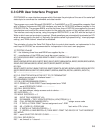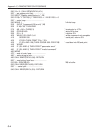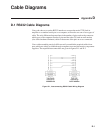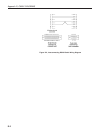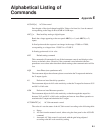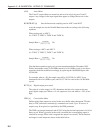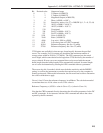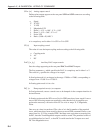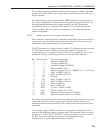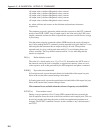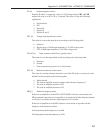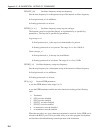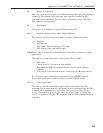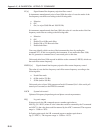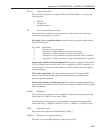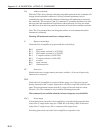
E-5
Appendix E, ALPHABETICAL LISTING OF COMMANDS
The computer program’s subroutine which reads the responses to the DC command
needs to run a FOR...NEXT loop of length equal to the value set by the LEN (curve
length) command.
Note that when using this command with the GPIB interface the serial poll must be
used. After sending the DC command, perform repeated serial polls until bit 7 is set,
indicating that the instrument has an output waiting to be read. Then perform
repeated reads in a loop, waiting each time until bit 7 is set indicating that a new
value is available. The loop should continue until bit 1 is set, indicating that the
transfer is completed.
DCT n Dump acquired curves to computer in table format
This command is similar to the DC command described above, but allows transfer of
several curves at a time and only operates in fixed point mode. Stored curve(s) are
transferred via the computer interface in decimal format.
The DCT parameter is an integer between 1 and 65,535, being the decimal equivalent
of a 16-bit binary number. When a given bit in the number is asserted, the
corresponding curve is selected for transfer. When a bit is negated, the curve is not
transferred. The bit corresponding to each curve is shown in the table below:
Bit Decimal value Curve and output range
0 1 X Output (±10000 FS)
1 2 Y Output (±10000 FS)
2 4 Magnitude Output (±10000 FS)
3 8 Phase (±18000 = ±180°)
4 16 Sensitivity setting (4 to 27) + IMODE (0, 1, 2 = 0, 32, 64)
5 32 ADC1 (±10000 = ±10.0 V)
6 64 ADC2 (±10000 = ±10.0 V)
7 128 Not used
8 256 DAC1 (±10000 = ±10.0 V)
9 512 DAC2 (±10000 = ±10.0 V)
10 1024 Noise (±10000 FS)
11 2048 Ratio (±10000 FS)
12 4096 Log ratio (-3000 to +2000)
13 8192 EVENT variable (0 to 32767)
14 16384 Reference frequency bits 0 to 15 (mHz)
15 32768 Reference frequency bits 16 to 32 (mHz)
The values of the selected curves at the same sample point are transferred as a group
in the order of the above table, separated by the chosen delimiter character and
terminated with the selected terminator. This continues until all the points have been
transferred.
As an example, suppose CBD 5 had been sent, equivalent to asserting bits 0 and 2,
then the X and Magnitude outputs would be stored. The permitted values of n would
therefore be 1, 4 and 5. DCT 1 and DCT 4 would only transfer one curve at a time,
but DCT 5 would transfer the X output curve and the Magnitude curve
simultaneously. A typical output data sequence would be:



